ECO mode AUDI A4 2013 Owner's Manual
[x] Cancel search | Manufacturer: AUDI, Model Year: 2013, Model line: A4, Model: AUDI A4 2013Pages: 302, PDF Size: 75.61 MB
Page 115 of 302

Audi drive select Driving settings
Introduction
Appl ies to vehicles: wit h Audi drive select
Drive select provides the possibility to experi
ence different types of vehicle settings in one
veh icle. For instance, using the three
Com
fort, Auto and Dynamic modes, the driver can
switch from a sporty to a comfortab le driving
mode with the press of a button.
Addit ionally, in vehicles with
MM I*, the vehi
cle setup for
Individual* mode can be cus
tomized by you. This makes it possib le to
combine settings such as a sporty engine tun
ing with comfortable steering.
A WARNING
Improper use of the Audi drive select can
cause collisions, other acc idents and seri
ous personal injury.
Description
Applies to vehicles: w it h Audi drive select
The vehicle setup in each mode depends on
the vehicle's features. However, the engine,
automatic t ransmission* and steering are al
ways involved.
-
Engine and automatic transmission*
Depending on the mode, the engine and the
automatic transmission respond quicker or in
a more ba lanced manner to accelerator pedal
movements. In the sporty dynamic mode, the
automatic transmission shifts at higher RPMs .
Steering
The steering adapts in terms of steering effort
and steering ratios. Indirect steer ing that
moves easily, like the steering in comfort
mode, is best su ited to long dr ives on a high
way. In contrast, dynamic mode prov ides
sporty, direct steering.
The follow ing applies to vehicles with dynam ic
steer ing*: the steering ratio changes based on
veh icle speed in order to maintain optimum
Audi drive select 113
steering effort for the driver at all times. This
sets the steering to be less sensitive at higher
speeds in order to provide improved vehicle
control. At reduced speeds, however, steering
is more direct in order to keep the steering ef
fort as minimal as possible when the driver is
maneuveri ng the vehicle . At low and average
speeds, dynamic steering addit iona lly pro
vides more responsive steering performance.
Adaptive dampers*
The adaptive dampers* use sensors to record
information regarding steering movements,
braking and acceleration operations by the
drive r, road surface, driving speed, and load.
T his makes it possible to adapt damp ing to
the driving situation virtually i n rea l time.
Drive select also makes it possible to satisfy
the desire for sporty suspension (Dynamic)
and comfortab le suspension (Comfort) with
out giving up balanced tuning (Auto) .
Sport differential*
As a component of the all wheel dr ive system
(quattro ®)
q poge 191, the sport differential*
distributes the driving power to the rear axle
depending on the situation . The distribution
of power varies depending on the mode se lected. The goal is a high level of agility and
ability to accelerate on curves . The vehicle is
very respons ive to steering .
Audi adaptive cru ise control*
The behavior when accelerating can be adjust
ed from comfortab le to sporty, depending on
the drive select mode. Adaptive cruise control
also responds to the driving behavior of the
vehicle ahead in a more conservative or sporty
manner .
Engine sound*
The sound of the engine is adapted to the se
lected mode and ranges from subtle to sporty.
0) Tips
-In some models, the maximum vehicle
speed can only be reached in the
Auto
and Dynamic modes.
Page 120 of 302

118 Park ass is t
Vehicles with the parking system are equipped
with a rear view c am era in addition to the
acoustic parking system.
You can choose between two modes to assist
you with park ing. For example, you can use
"parking mode 1" when parking in a parking
space or garage
c:> fig . 128. When you want to
park parallel to the edge of the street, select
"park ing mode 2"
c:> fig. 129.
The rear acoustic park assist system is inte
grated in the rear of the vehicle and the rear
view camera is integrated in the rear lid
c:>page 119.
A WARNING
- T he rear view camera has blind spots, in
wh ich objects ca nnot be detected . Be es
pecially careful to check for small ch il
dre n and an imals before back ing up .
Small ch ild ren and anima ls w ill not al
ways be detected by the sensors .
General Information
Applies to vehicles: with parking system (rear, with rear
view camera)
Fig . 130 Cove red area (!) and u ncovered a rea @ of the
rea r view ca mera
• 0
F ig . 131 Tr unk lid: Location of the rea r view camera
"'
"' "'
~
Sensors a re loca ted in the rear b umpe rs. If
these detect an obstacle, audible and visual s ignals warn you . The range at which the sen
sors begin to measure is approx imately:
To the side
2 ft (0 .60 m)
Center rear 5.2 ft (1.60 m)
Distance warn ing when reversing starts whe n
an obstacle is detected in the range of the parking assist system . As the d istance de
creases, the time interval between the audible
tones becomes shorter.
When the distance is less than 1ft
(0 .30 m),
t h e tone becomes continuous. At t his point
you should stop backing up.
If the distance to an obstacle stays the same,
the volume of the dista nce signal chime is
gradually reduced after about 4 seconds (does
not affect the contin uous signa l tone) . Ap
proaching another obstacle will cause the d is
tance signal to sound agai n at the normal vo l
ume.
R ea r v iew camera coverage area
T he M MI display shows the area covered by
the rear view camera
c:> fig. 130 (D . Objects
that are not in the area covered @are not
shown on the MMI display .
We recommend that you practice parking with
the rear view camera in a traffic-free location
or parking lot to become familiar with the sys
tem, the or ientation lines, and the ir function.
When doing this, there should be good light and weathe r cond itions.
In the MMI display, objects or vehicles appear
closer or further away if:
- you are driving in reverse gear from a leve l
surface onto an incline , or a downward
slope,
- you are driving in reverse gear toward pro
trud ing ob jects,
- the vehicle is car ry ing too much load in the
rear.
Page 125 of 302

Homelink®
Universal remote
control
Description
Applies to vehicles: with Home link
The HomeLink universal remote control con
be programmed with the remote control for
devices that ore already present.
With Home Link, you can control devices such
as the garage door, secu rity systems, ho use
lights , etc. comfortably from the inside of you
vehicle .
H omelink makes it poss ible for you to rep lace
three different remote controls from dev ices
i n your home with one universal remo te. Th is
featu re works for most garage door and exte
rior door motor signals. Programming the in
d ividual remote control for your remote con
trol takes p lace near the center of the radiator
grille. There is a control module attached at
this location .
A one-t ime programm ing of the sensor must
be performed before you are able to use sys
tems with Homelink. If the system does not activate after performing the one-t ime pro
gramming, check whether the system uses a rolling code ¢
page 126 for vehicles without
the MMI*.
,& WARNING
-
-Never use the Homelink ® transmi tter
with any garage door opener that does have not the sa fety stop and reverse fea
ture as requ ired by federa l safety stand
ards. Th is includes any garage door open
er mode l manufactured before April 1,
1982.
- A garage door opener which cannot de
tect an object, signaling the door to stop
and reverse does not meet current feder
al safety standards . Us ing
a garage door
opener without these features increases
risk of serious injury or death.
Homelink ® 123
-For safety reasons never re lease the
parking brake or start the eng ine while
anyone is standing in front of the vehicle .
- A garage door or an estate gate may
sometimes be set in motion when the Homelink ® remote control is being pro
grammed. If the device is repeatedly ac
tivated, th is can overstrain motor and
damage its e lectrical components -an
overheated mo to r i s
a fire hazard!
- To avoid possib le injuries or property
damage, please always make abso lutely
certain that no person s or objects are lo
cated in the range of motion of any
equ ipment being operated .
(D Tips
-If you would like more information on
Homelink ®, where to purchase the
Home link ® compatib le products, or
would like to purchase the Homelink ®
Home Lighting Package, please ca ll toll
free: l-800-355-3515.
- For Declaration of Compliance to United
States FCC and Industry Canada reg ula
tions¢
page 283.
- For security reasons, we recommend that
you clear the programmed b uttons be
fore selling the veh icle.
Operation
App lies to vehicles : with Homeli nk
~~''' r ·O : O ·) 1111
~
®
Fig . 1 36 Head li ner: controls
Req uirement : The buttons must be program-
med
<:!)page 124 or ¢page 125. ..,_
Page 126 of 302
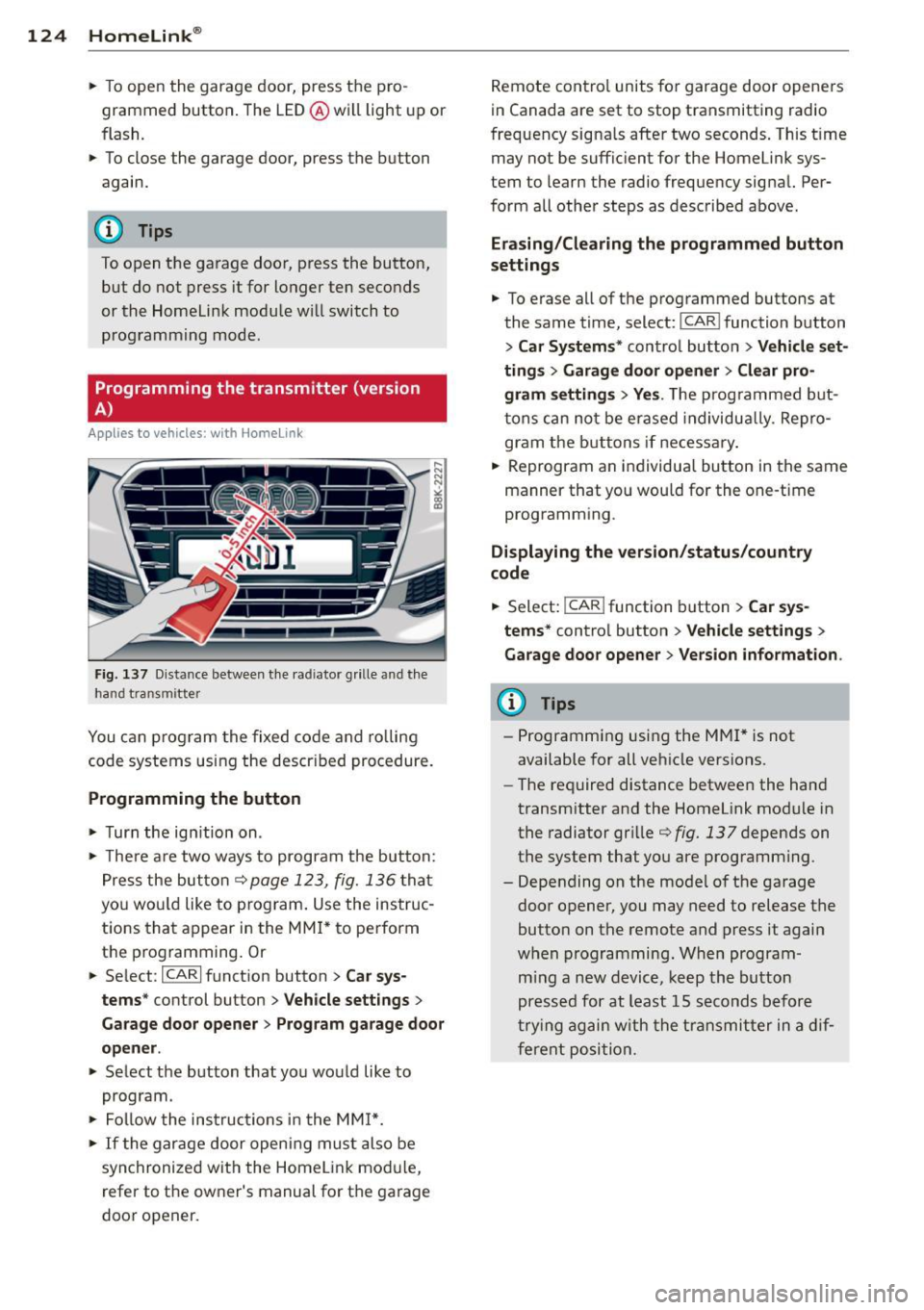
124 Homelink®
• To open the garage door, press the pro
grammed button. The LED @will light up or
flash.
• To close the garage door, press the button
again.
@ Tips
To open the garage door, press the button, but do not press it for longer ten seconds
or the Homelink module will switch to
programming mode.
Programming the transmitter (version
A)
Appl ies to vehicles : wit h Home li nk
Fig. 137 Distance between the radia tor grille and the
hand transmitter
You can program the fixed code and rolling
code systems using the described procedure.
Programming the button
• Turn the ignition on .
• There are two ways to program the button:
Press the button¢ page
123, fig. 136 that
you would like to program. Use the instruc
tions that appear in the MMI* to perform
the programming. Or
• Select:
I CARI function button > Car sys
tems*
control button > Vehicle settings >
Garage door opener> Program garage door
opener .
• Select the button that you would like to
program.
• Follow the instructions in the
MMI*.
• If the garage door opening must also be
synchronized with the Homelink module,
refer to the owner's manual for the garage
door opener. Remote
control units for garage door openers
in Canada are set to stop transmitting radio
frequency signals after two seconds. This time
may not be sufficient for the Home link sys
tem to learn the radio frequency signal. Per·
form all other steps as described above .
Erasing/Clearing the programmed button
settings
• To erase all of the programmed buttons at
the same time, select:
I CAR I function button
> Car Systems" control button > Vehicle set
tings
> Garage door opener> Clear pro
gram settings > Yes.
The programmed but
tons can not be erased individually . Repro
gram the buttons if necessary.
• Reprogram an individual button in the same
manner that you would for the one-time
programming .
Displaying the version/status/country
code
• Select: I CAR ! function button > Car sys·
terns*
control button > Vehicle settings >
Garage door opener> Version information .
(D Tips
-Programming using the MMI* is not
available for all vehicle versions.
- The required distance between the hand
transmitter and the Homelink module in
the radiator grille ¢fig.
137 depends on
the system that you are programming .
- Depending on the model of the garage
door opener, you may need to release the
button on the remote and press it again
when programming. When program
ming a new device, keep the button
pressed for at least 15 seconds before
trying again with the transmitter in a dif
ferent position.
Page 127 of 302
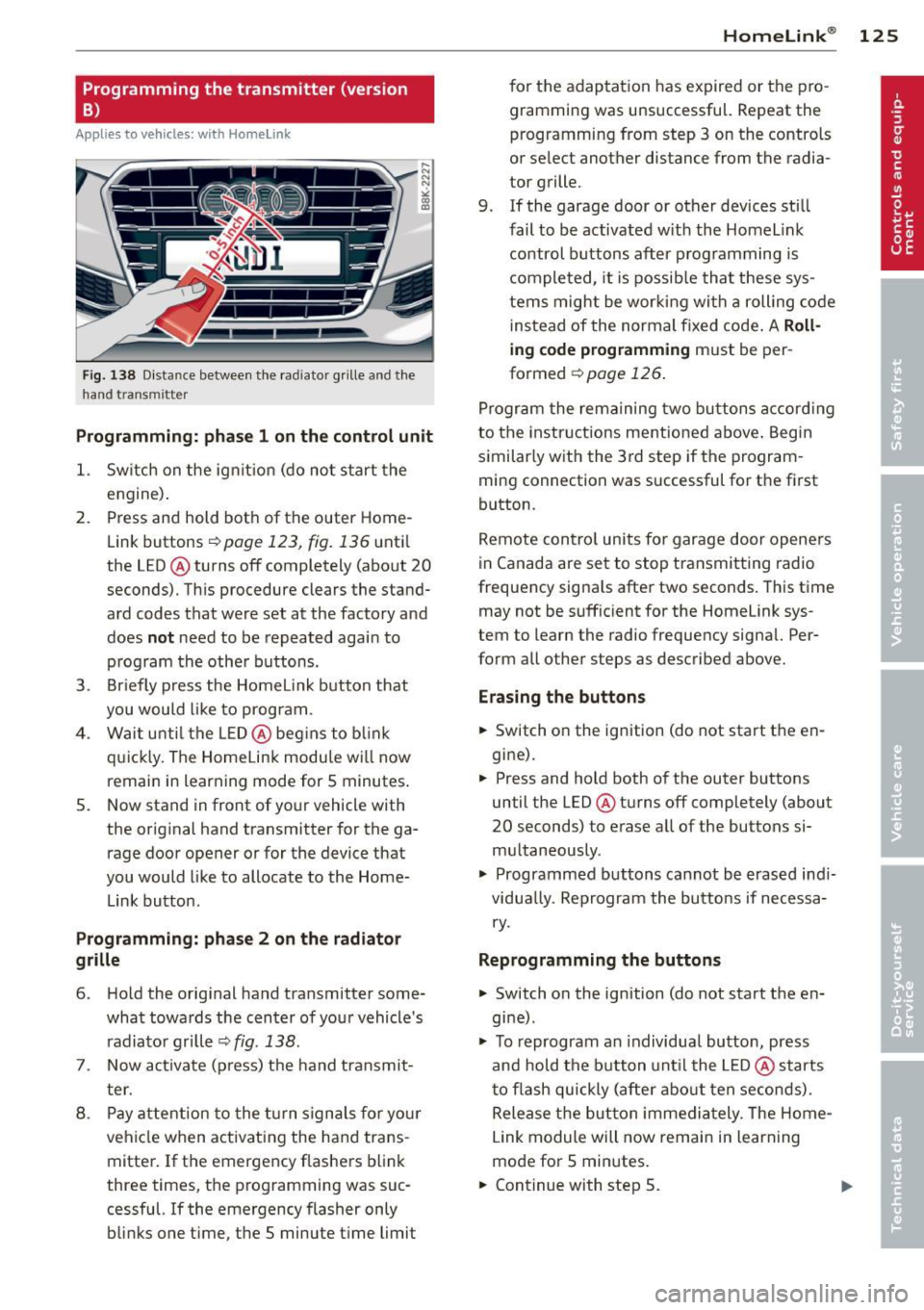
Programming the transmitter (version
B)
Applies to vehicles: with Horne link
Fig. 1 38 D istance between t he rad ia tor grill e and t he
hand transmitte r
Programming: phase 1 on the control unit
1. Sw itch on the ig nit io n (d o n ot start the
e ngine ).
2. P ress and hold bot h of the outer Home
Link buttons
r=> page 123, fig. 136 unt il
the LED @ turns off completely (about
20
seconds). Th is procedure clears the stand
ard codes that were set at the factory and
does
not need to be repeated agai n to
p rog ram th e othe r buttons.
3. Briefly press the Homelink button that
you would like to prog ram .
4 . Wai t until the LED@ beg ins to blink
q ui ckly. The Home Lin k modu le wi ll now
remai n in learning mode for
5 minutes .
5. Now stand in front of your vehicle with
the original hand transmitter for the ga rage door opener o r for the device that
you would like to allocate to the Home
Link button.
Programming: pha se 2 on the radiator
grille
6 . Hold the o rig inal hand transmitter some
what towa rds the center o f you r vehicle 's
radiato r gr ille
r=> fig . 138 .
7. Now activate (p ress) t he hand transmit
ter.
8 . Pay a ttention to the t urn sign als for yo ur
vehicle when activating the ha nd trans
mitter . If t he emergency flashers b link
three times, the programming was suc
cessful. If the emergency flasher only
bli nks one time, the 5 minute t ime limit
Homelink ® 125
for the adaptat ion has expired or the pro
gram ming was unsuccessful. Repeat the
programming from step 3 on the controls
o r se lect another distance from the radia
tor grille.
9. If the garage door or other devices sti ll
fail to be activated w it h the Homelink
control buttons after p rogramming is
comple ted, it is possib le tha t these sys
tems might be wor king with a roll ing code
ins tead of the normal fixed code .
A Roll
ing code programming must be per
formed
r=> page 126 .
Program the rema ining tw o b uttons a ccord ing
to the instructions mentioned above . Beg in
similar ly w ith the 3rd step if the program
m ing connection was successful for t he first
button .
Remote con trol units fo r garage door opene rs
in Canada are set to stop transmitting radio
frequency signa ls after two seconds . This time
may not be suffic ient for the Homelink sys
tem to learn the radio frequency signa l. Per
form all other steps as described above.
Erasing the buttons
.,. Switch o n the ignition (do not start the en
gi ne).
.,. Press and hold both of the outer buttons
until the LED @ turns off completely (about
20 seconds) to erase all of the buttons si
m ultaneously .
.,. Programmed buttons cannot be erased ind i
vidua lly. Reprogram the buttons if necessa
ry .
Reprogramming the buttons
.,. Switch on the ignition (do not start the en
gine) .
.,. To reprogram an individua l butto n, press
and hold the button unt il the LED @ starts
to f lash quickly (after abo ut ten seconds) .
Release t he bu tton imme dia tely. The Home
L ink module will now remain in learning
mo de for 5 minutes.
.,. Continue with step 5.
Page 128 of 302
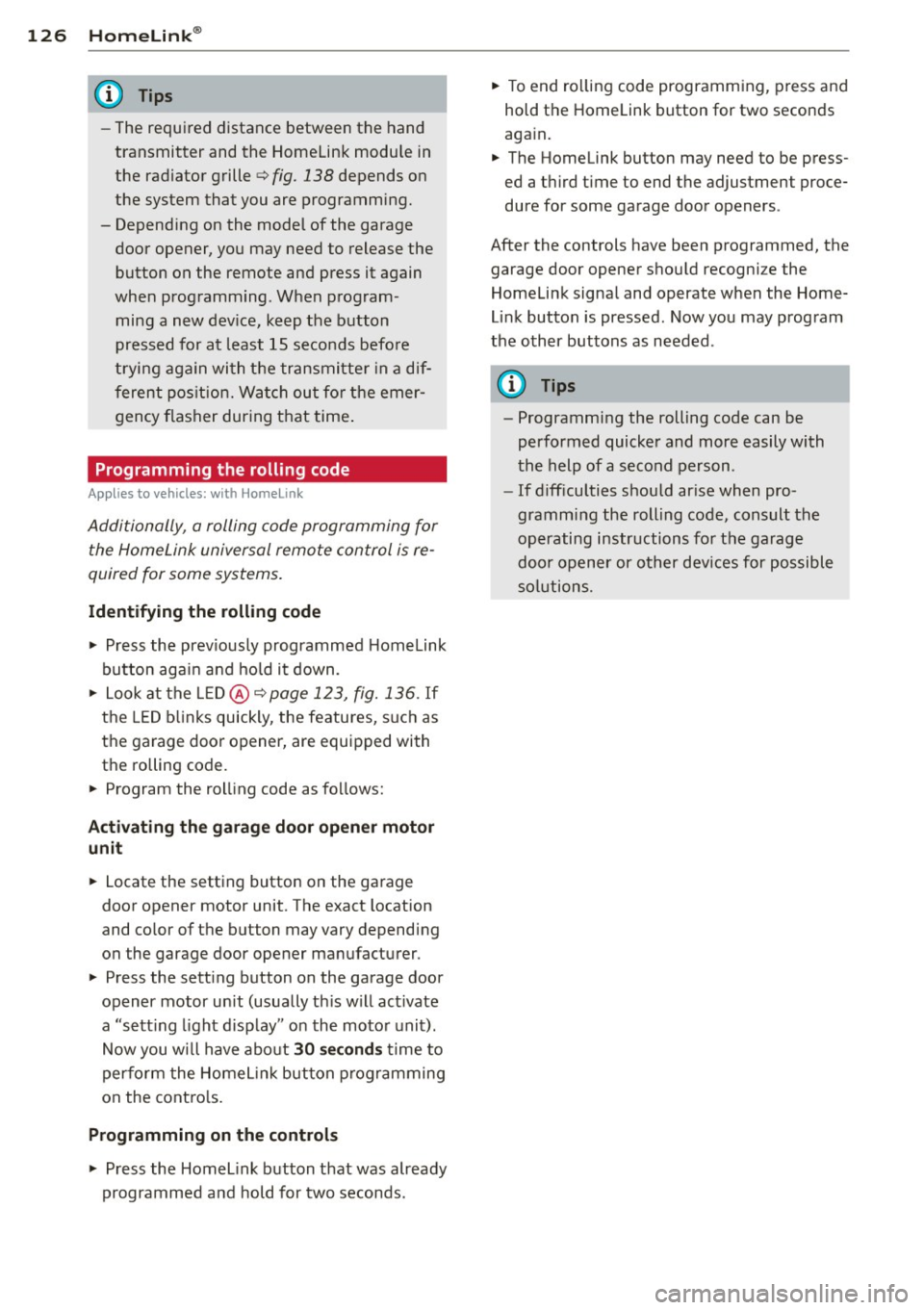
126 Hom eli nk®
-The required distance between the hand
transmitter and the HomeLink module in
the radiator grille
c:> fig. 138 depends on
the system that you are programming.
- Depend ing on the model of the garage
door opener, you may need to release the
button on the remote and press it again
when programming . When program
ming a new dev ice, keep the button
pressed for at least 15 seconds befo re
trying again with the transmitter in a dif
ferent pos it ion. Wa tch out fo r the emer
gency flasher during that time .
Programming the rolling code
Applies to vehicles: with Home link
Additionally, a rolling code programming for
the HomeLink universal remote control is re
quired for some systems .
Identifying the rolling code
.. Press the prev ious ly programmed Homelink
button aga in and hold i t down .
.. Look at the LED@ c:>
page 123, fig. 136 . If
the LED b links quickly , the features, s uch as
the garage door opener, are equipped with
the rolling code .
.. Program the roll ing code as fo llows:
Act ivating the g arage door opener motor
unit
.. Locate the sett ing button on the garage
door opener motor unit . The exact location
and co lor of the button may vary depending
on the garage door opener manufacturer .
.. Press the sett ing button on the garage door
opener motor unit (usually th is w ill act ivate
a "sett ing light d isp lay" on the motor unit).
Now you w ill have about
30 second s time to
perform the HomeL ink button programming
on the cont ro ls.
Programming on the controls
.. Press the Home L ink button that was already
programmed and hold for two seconds . ..
To end ro lling code programm ing, press and
hold the Home link button for two seconds
aga in .
.. The Homelink button may need to be press
ed a third t ime to end the adjus tment proce
dure for some garage door openers .
After the controls have been programmed, the garage door opener should recogni ze the
Homelink signal and operate when the Home
Li nk button is pressed . Now you may program
the other buttons as needed .
(D Tips
-Programming the rolling code can be
performed quicker and more easily with
the help of a second person .
- If d iff iculties should arise when pro
gramming the rolling code, consult the
operating instructions for the garage
door opener or o ther dev ices for po ssible
solutions.
Page 161 of 302
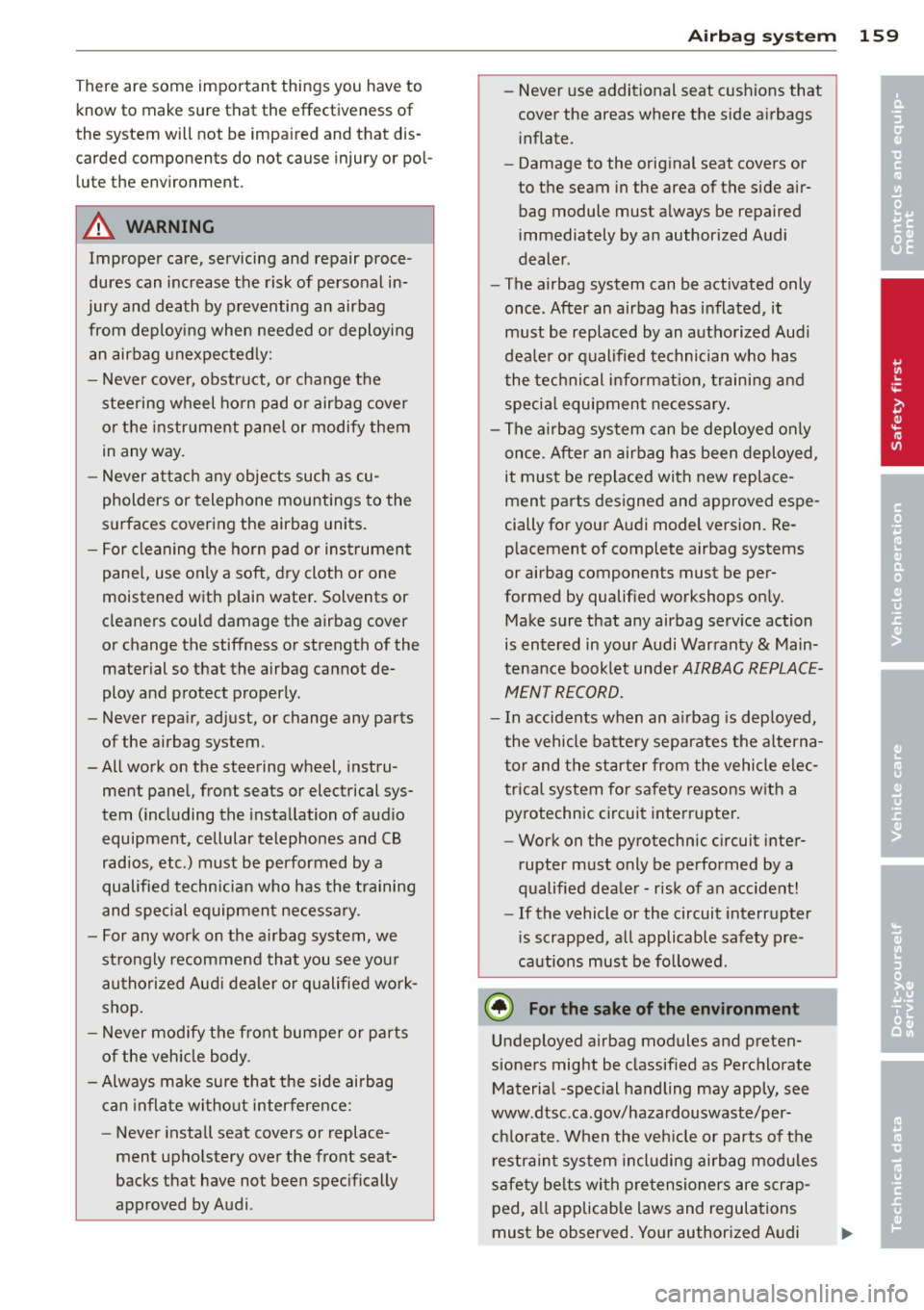
There are some important things you have to know to make sure that the effectiveness of
the system will not be impaired and that dis
carded components do not cause injury or pol
lute the environment.
A WARNING
Improper care, servicing and repair proce
dures can increase the risk of personal in
jury and death by preventing an airbag from deploying when needed or deploying an airbag unexpectedly:
- Never cover, obstruct, or change the
steering wheel horn pad or airbag cover
or the instrument panel or modify them
in any way .
- Never attach any objects such as cu
pholders or telephone mountings to the
surfaces covering the airbag units.
- For cleaning the horn pad or instrument
panel, use only a soft , dry cloth or one
moistened with plain water. Solvents or
cleaners could damage the airbag cover
or change the stiffness or strength of the
material so that the airbag cannot de
ploy and protect properly.
- Never repair, adjust, or change any parts
of the airbag system .
- All work on the steering wheel, instru
ment panel, front seats or electrical sys
tem (including the installation of audio
equipment, cellular telephones and CB
radios, etc.) must be performed by a
qualified technician who has the training
and special equipment necessary.
- For any work on the airbag system, we
strongly recommend that you see your
authorized Audi dealer or qualified work
shop.
- Never modify the front bumper or parts
of the vehicle body .
- Always make sure that the side airbag
can inflate without interference:
- Never install seat covers or replace
ment upholstery over the front seat
backs that have not been specifically
approved by Audi .
Airbag system 159
-Never use additional seat cushions that
cover the areas where the side airbags
inflate.
- Damage to the original seat covers or
to the seam in the area of the side air
bag module must always be repaired
immediately by an authorized Audi
dealer .
- The airbag system can be activated only
once . After an airbag has inflated , it
must be replaced by an authorized Audi
dealer or qualified technician who has
the technical information, training and
special equipment necessary.
- The airbag system can be deployed only
once . After an airbag has been deployed,
it must be replaced with new replace
ment parts designed and approved espe
cially for your Audi model version. Re placement of complete airbag systems
or airbag components must be per
formed by qualified workshops only.
Make sure that any airbag service action
is entered in your Audi Warranty
& Main
tenance booklet under
AIRBAG REPLACE
MENT RECORD.
- In accidents when an airbag is deployed,
the vehicle battery separates the alterna
tor and the starter from the vehicle elec
trical system for safety reasons with a
pyrotechnic circuit interrupter.
- Work on the pyrotechnic circuit inter
rupter must only be performed by a
qualified dealer - risk of an accident!
- If the vehicle or the circuit interrupter
is scrapped, all applicable safety pre
cautions must be followed.
{® For the sake of the environment
Undeployed airbag modules and preten
sioners might be classified as Perchlorate Material -special handling may apply, see
www.dtsc .ca.gov/hazardouswaste/per-
ch lorate. When the vehicle or parts of the
restraint system including airbag modules
safety belts with pretensioners are scrap ped, all applicable laws and regulations
must be observed. Your authorized Audi .,..
•
•
Page 170 of 302

168 Child Saf ety
same kind of child rest raint offered by child
restraint manufact urers.
The weight ranges fo r the ind ividual types,
makes and mode ls o f chi ld restra ints that the
NHTSA has specified in the Safety Standard
together with the weight ranges of typical in
fants and typical 1 year-o ld child have been
stored in the control unit of the Advanced A ir
bag System. When a child restraint is being
used on the front passenger seat with a typi
cal 1 year-old ch ild, the Advanced Airbag Sys
tem compa res the we ight measured by the
weight sensing mat with the informat io n sto r
ed i n the ele ct ron ic cont ro l uni t.
The electron ic control unit also registers the
tension on the front passenge r safety belt .
The tens io n on the safety be lt fo r the front
passenger seat will be d iffe ren t for an ad ult
who is prope rly using the safety belt as com
pared to the tension on the be lt whe n it is
used to attach a chi ld restraint to the seat.
The sensor below the latch for the safety be lt
for the front seat passenger meas ures the
tension on the be lt. The input from this sen
sor is then used with the we ight to "decide",
whether there is a ch ild restraint w ith a typ ical
1 year-o ld child o n the front passenger seat
and whe ther or not the ai rbag must be tu rned
off.
Child restraints and Advanced Airbags
Regardless o f the child restraint t hat you use,
make sure that it has been ce rtified to meet
United States Federal Motor Vehicle Safety
Standards and has been certified by its manu
facturer for use with a n airbag. Always be sure
that the child restraint is properly instal led at
one of the rear seat ing pos itions .
If in excep
tional c ircumstances you must use it on the
fro nt passenger sea t, caref ully read all of the
i n format ion on c hild safety and Advanced A ir
bags and heed a ll of the app licab le WAR N
I NGS . Ma ke certain that the child restraint is
correctly recognized by the weig ht-sensing
mat inside the front passenger seat, that the
fro nt passenger airbag is turned off and that the a
irbag sta tus is always cor rect ly signa led
by the
PASSENGER AIR BAG OFF light .
Many types and models of child res traints
h ave been available over the yea rs, new mod
els are introduced regu larly incorporating new
and improved designs and o lde r mode ls are
ta ken out o f product ion . Ch ild restra ints are
not standard ized . Child restraints of the same
type typically have different weights and sizes
and different 'footpr ints,' the size and shape
of the bottom of the ch ild restra int that sits
on the seat, when they are insta lled on a vehi
cl e seat. These d iffe rences make it v irtually
i mpossible to certify compl ian ce wi th t he re
quiremen ts for advanced airbags with eac h
and every chi ld restraint that has eve r been
sold in the past or wi ll be sold over the course
of the useful life of your veh icle.
F or t his reason, the United S tates National
Highway T raffic Safety Adm inist ration has
published a list of specific type, ma kes and
models of child restraints that must be used
to certify comp liance of the Advanced Airbag
System i n your veh icle with the suppression
requirements of Federal Motor Vehicle Safety
Standa rd 208. These ch ild restraints a re:
Subpart A -Car bed child re straints
Model
A ngel Guard Angel
Ride AA2403FOF
Manufactured on or
after
September 25, 2007
Subpart B -Rear-facing child restraints
Model Manufactured on or
after
Ce ntury 5martFit December 1, 19 99
4 543
Cosco Arriva September 25, 2007
I
22-013PAW and base
22-999WHO
I
Evenflo Discove ry Ad- December 1, 1999
just Right 212
Evenflo First Choice December 1, 1999
20 4
Graco Infant 8457 December 1, 1999
Page 189 of 302
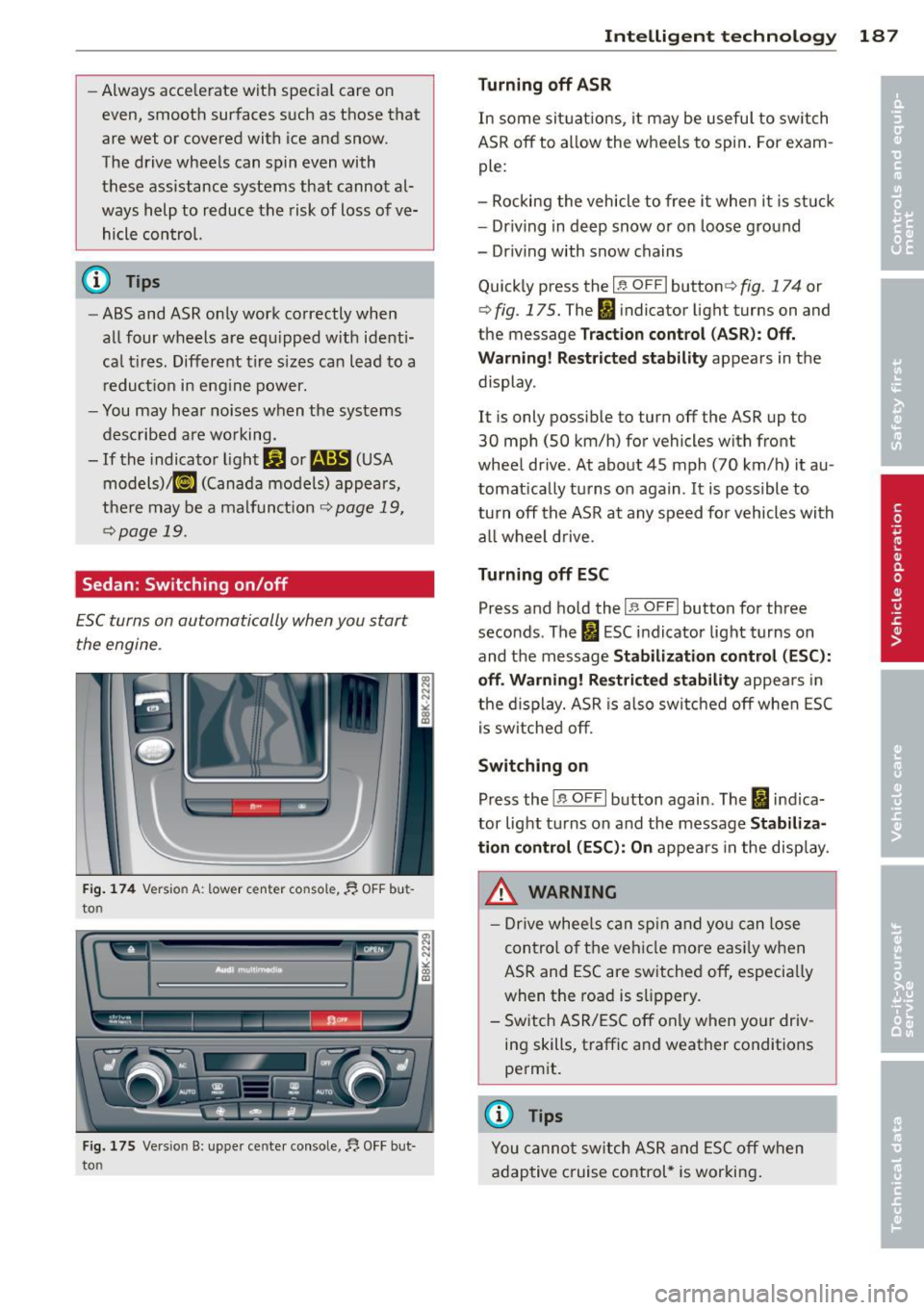
-Always acce lerate with specia l care on
even, smooth surfaces s uch as those that
are wet or covered with ice and snow.
The drive wheels can spin even with
these assistance systems that cannot al
ways help to reduce the risk of loss of ve hicle control.
(0 Tips
- ABS and ASR on ly work correctly when
all four wheels are equ ipped w ith ident i
ca l tires. Different tire s izes can lead to a
reduct ion i n eng ine power.
- You may hear noises when the systems
described are wo rking .
- If the indicator light D] or m!S (USA
models) ;tiJ (Canada models) appears,
the re may be a malfunct ion
c:> page 19,
~ page 19.
Sedan : Switching on/off
ESC turns on automatically when you start
the engine .
Fig . 174 Vers io n A: low er c en te r co nsol e, 1', O FF bu t
to n
Fig. 175 Ve rsio n B: upper ce nte r console,~ OFF bu t
to n
Intelligen t technolog y 187
Turning off ASR
In some sit uatio ns, it may be useful to switch
ASR
off to a llow the wheels to spin . For exam
ple:
- Rocking the vehicle to free it when i t is st uck
- Dr iving in deep snow or on loose ground
- Dr iving with snow chains
Qu ick ly press the
I~ O FF I button c:> fig. 174 or
c:>
fig . 175. The fil indica tor light turn s on and
t he me ssage
T rac tion control (A SR ): Off.
War ning! R estrict ed stability
appears in the
display .
It i s only possible to turn
off the ASR up to
30 mph (SO km/h) for vehicles wi th front
wheel drive . At about 45 mph (70 km/h) it au
tomat ically turns on again .
It is possible to
turn
off the ASR at any speed fo r vehicles with
all wheel drive .
Turning off ESC
Press and hold the I;; OFFI button for three
seconds . The
fl ESC indicator light turns on
and the message
Stabil ization cont rol (ESC ):
o ff . Warni ng ! Re str icted stab ilit y
appea rs in
the d isplay. ASR is also sw itched
off when ESC
i s sw itched off.
Switching on
Press the j ;; O FFI button again . The fi indica
tor light t urns on and the message
St abi liz a
t ion control (ESC ): On
appears in the disp lay.
_&. WARNING
- Drive whee ls can sp in and you can lose
contro l of the vehicle more eas ily when
ASR and ESC are switched off, especia lly
when the road is s lippery .
- Switch ASR/ESC
off only when yo ur driv
ing skills, traffic and weather conditions
permit.
@ Tips
You cannot sw itch ASR and ESC off when
adaptive cruise control* is working .
-
Page 198 of 302
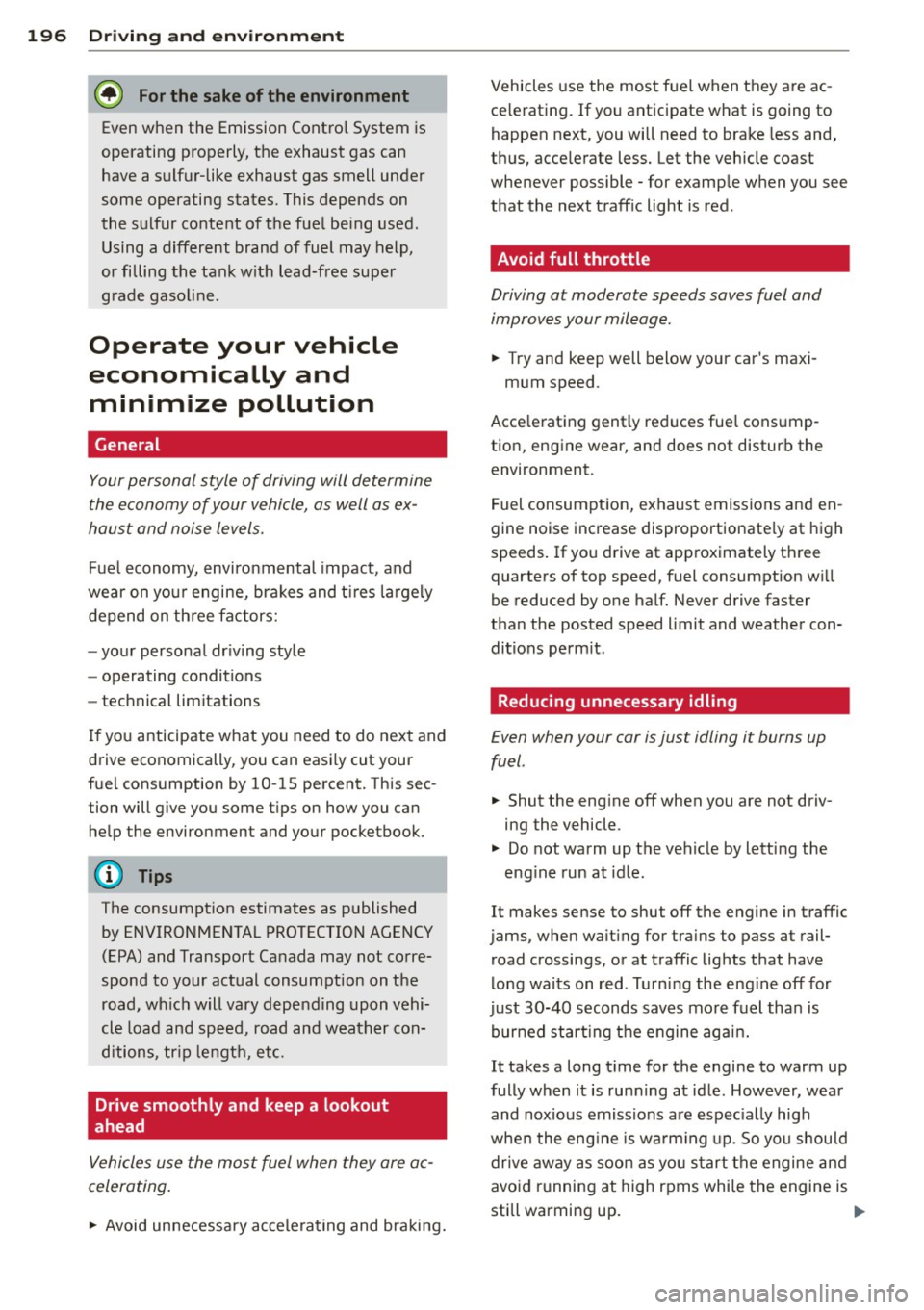
196 Driving and en vironm ent
@ For the sa ke of the environment
Even when the Emission Contro l System is
operating properly, the exhaust gas can
have a sulfur-like exhaust gas smell under
some operating states. This depends on
the sulfur content of the fue l being used .
Using a different brand of fuel may help,
or filling the tank w ith lead-free super
grade gasoline.
Operate your vehicle
economically and minimize pollution
General
Your personal style of driving will determine
t he economy of your vehicle, as well as ex
haust and noise levels.
Fue l economy, environmental impact , and
wear on you r engine, bra kes and t ires la rgely
depend on th ree factors:
= yo ur personal dr iv ing sty le
- operating conditions
- technical lim itations
If yo u anticipate what you need to do next and
drive economically, you can easi ly cut your
fue l consumption by 10-15 percent. This sec
tion will give you some t ips on how you ca n
he lp the environmen t and your pocketbook.
(D Tips
The consumpt ion estimates as published
by ENVIRONMENTAL PROTECTION AGENCY
(EPA) and Transport Canada may not co rre
spond to your actual consumption on the
road, wh ich will vary depending upon vehi
cle load an d speed, road and weather con
ditions, tr ip le ngth, etc.
Drive smoothly and keep a lookout
ahead
Vehicles use the most fuel when they are ac
celerating .
.,. Avoid unnecessa ry accelerating and braking. Vehicles use the most fuel when they are ac
ce le rating. If you anticipate what is going to
happen next, you will need to brake less and,
th us, acce lerate less. Let the vehicle coast
whenever possible -for example when you see
that the next traff ic light is red .
· Avoid full throttle
Driving at moderate speeds saves fuel and
improves your mileage.
.. Try and keep well below your car's maxi-
m um speed .
Acce lerat ing gently red uces fue l cons ump
tion, engine wear, and does not disturb the
environment.
F uel consumpt ion, exhaust emissions a nd en
gine noise inc rease disproportionate ly at high
speeds . If yo u drive at approximately th ree
quarters of top speed, fuel consumption w ill
be reduced by one half. Never drive faster
than the posted speed limit and weathe r con
ditions pe rm it.
Reducing unnecessary idling
Even when your car is jus t idling it burns up
fuel.
.. Shut the eng ine off when you are not driv
ing the vehicle .
.. Do not warm up the vehicle by letti ng the
eng ine run at idle .
It makes sense to shut off the engine in traffic
jams, when wa it ing for tra ins to pass at rail
r oad crossings, or at traffic lig hts that have
long wai ts on red . Tu rn ing the eng ine off for
j ust 30-40 seconds saves more fuel tha n is
burned start ing t he e ngine aga in.
It takes a long t ime for the engine to warm up
fully when it is ru nning at id le. However, wea r
and noxious emissions a re espec ia lly high
whe n the eng ine is wa rm ing up. So you s hou ld
dr ive away as soon as yo u start the engine and
avo id running at high rpms whi le the engine is
still warming up.
ll-